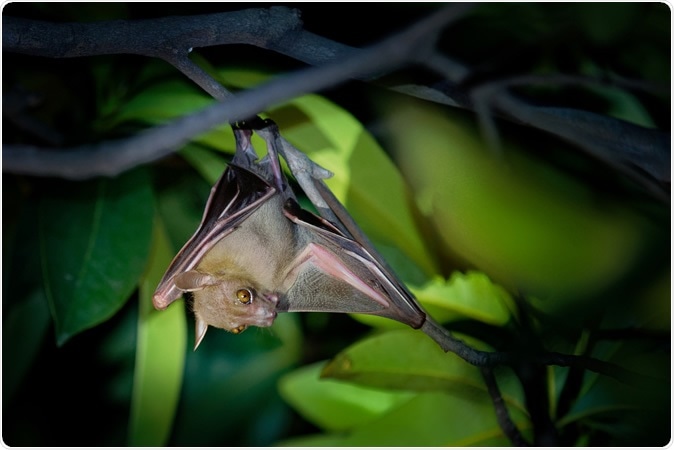
Lesser Short-nosed Fruit Bat - Cynopterus brachyotis species of megabat within the family Pteropodidae. Image Credit: Martin Pelanek / Shutterstock
The ongoing, disruptive pandemic of coronavirus disease 2019 (COVID-19) is caused by severe acute respiratory syndrome coronavirus 2 (SARS-CoV-2). The spillover event to humans likely occurred in late 2019, and the exact source is still a matter of intense research debates.
But emerging infectious diseases due to coronavirus infections are not new and have received global attention after severe acute respiratory syndrome coronavirus (SARS-CoV) outbreak in 2002-2003 and the Middle East respiratory syndrome coronavirus (MERS CoV) outbreak in 2012. Together with SARS-CoV-2, all of them belong to the same group of Betacoronaviruses.
There is increasing evidence for the role of bats – one of the most widely distributed and diverse animals – as hosts of emerging pathogens, especially viruses. In particular, the aforementioned emerging human coronaviruses have been linked to bat sources. Moreover, the whole-genome analysis revealed that SARS-CoV2 is 96% identical to a bat coronavirus.
However, bat coronaviruses comprise only 6% of the current coronavirus database, even though approximately three thousand genetic lineages of bat coronaviruses are believed to circulate globally. Furthermore, based on specific bat species distribution, future coronavirus outbreaks may even be predicted on a geographical level.
These were primary reasons why researchers from the University of the Philippines Mindanao, University of the Philippines Manila, and Animal Solutions Veterinary Hospital in Bolcan decided to expand the knowledge on the evolution, diversity, distribution, host specificity, and zoonotic transmission of bat coronaviruses.
A deep gaze into the genes of coronaviruses
In order to classify representative and unresolved Betacoronaviruses, phylogenetic analysis of their RNA-dependent RNA polymerase (RdRp) sequences was pursued, while patterns of geographic and host distribution were done by network analysis. RdRp is an important enzyme that the virus uses to replicate its genome and carry out the transcription process.
Samples of bat coronaviruses were obtained from Southern Philippines from an exploratory surveillance effort. There were five sampling sites in total, comprised of two residential sites, two agricultural sites, and one forest site at Malagos, Davao City. Genomic material was extracted from small and large intestine samples.
"The analysis validated the current classification scheme of Betacoronaviruses with potentially novel groupings and subgroupings identified," study authors say. "Comparative phylogenetics demonstrated a strong tendency towards host specificity of bat Betacoronaviruses, although there was poor evidence of co-evolution with their hosts", they add.
Host specificity and potential spillovers
This study showed that certain bat taxa harbor multiple coronavirus lineages, and also points to bats as potential origins of other mammalian coronaviruses. Hence, the authors of this new study (available on bioRxiv preprint server) recommend that the database of Betacoronaviruses is continually expanded via continuous surveillance.
However, switching to another taxon would necessitate specific genetic alterations, which implies a strong selection pressure. Factors that hamper successful transmission to a different host taxon include viral replication fitness, host immune responses, and cell surface receptors.
All of them serve as critical natural barriers in the transmission of bat coronaviruses, which is why their evolution occurs in a step-wise fashion. In other words, host jumping and co-infection (which would otherwise produce new viral strains with the propensity to switch animal hosts) is severely limited. However, we cannot completely discount potential future spillover events.
"Continued ecological imbalances that alter bat distribution may eventually lead to loss of host specificity for bat Betacoronaviruses through cross-taxon transmission and adaptation of multiple coronavirus lineages", caution study authors.
"Diverse wildlife-livestock-human interfaces created by urbanization could further increase the selection pressure resulting in spillover events in human populations," they add.
Fruit bats as a risk forecasting model
This is precisely the case with the Cynopterus brachyotis (also known as the lesser dog-faced fruit bats), whose presence in urban Philippine communities makes them a hazard for future spillover infections in animal and human populations. And albeit the researchers have not detected coronaviruses in other fruit bat species, sampling bias may have played a role here.
"Should there be a novel zoonotic coronavirus arising from fruit bats such as Cynopterus brachyotis, it is predicted to be genetically distinct from SARS-CoV, SARS-CoV-2, or MERS-CoV", say study authors in regards to the host-specificity issue. "However, this novel virus may be just as virulent or highly contagious," they conclude.
In any case, ecological imbalances that muddle with bat distribution may even lead to the loss of host specificity and transmission of bat coronaviruses across taxa. Therefore, initiatives that reduce the destruction of wildlife habitats and restrict wildlife-livestock-human interfaces are vital to aid in maintaining the natural wild state of bat coronaviruses.

 *Important notice: bioRxiv publishes preliminary scientific reports that are not peer-reviewed and, therefore, should not be regarded as conclusive, guide clinical practice/health-related behavior, or treated as established information.
*Important notice: bioRxiv publishes preliminary scientific reports that are not peer-reviewed and, therefore, should not be regarded as conclusive, guide clinical practice/health-related behavior, or treated as established information.
Journal reference:
- Preliminary scientific report.
Bacus, M.G. et al. (2020). Global genetic patterns reveal host tropism versus cross-taxon transmission of bat Betacoronaviruses. bioRxiv. https://doi.org/10.1101/2020.05.04.076281